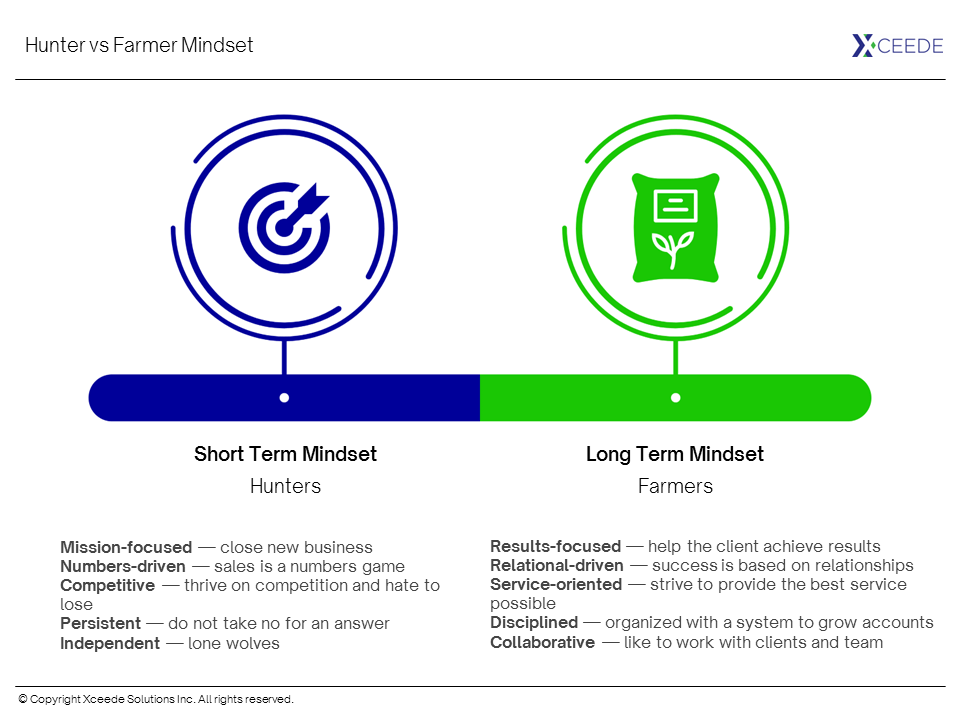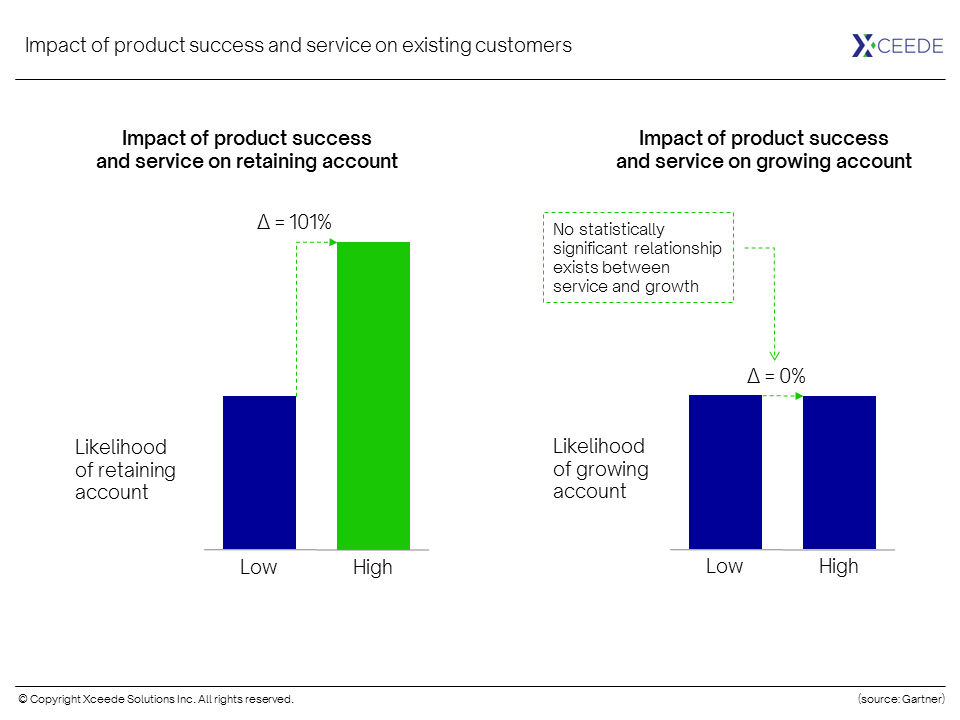According to Gartner, 62.3% of Chief Sales Officers rate improving account management and account-based strategies as a top priority for 2022.
For almost every company, existing customers represent a significant share of revenue. However, traditional approaches designed to retain existing customers do not necessarily translate into developing growth opportunities within the account base.
The challenge of growing existing accounts
Understanding the challenge begins with grasping the nature of the Account Manager position. At its core, the problem revolves around the following fact: the Account Manager must identify growth opportunities in order for the existing account growth engine to function. As such, the growth of existing accounts rests squarely on the Account Manager's shoulders.
Adrian Davis, author of Human-to-Human Selling, points out that recruiters have been leveraging two mental models to guide hiring: they seek hunters to fill Sales positions and farmers to fill Account Manager positions.
These models come from psychotherapist Thom Hartmann's work, who first identified them. Per Davis:
Traditionally, hunters in the Sales position focused on customer acquisition, while farmers in the Account Manager position focused on customer retention. As a result, the hunter mindset focuses too much on the short term, which leads to missing larger opportunities. On the other hand, the farmer mindset focuses too much on the long term, is too patient and leads to too much agreeableness towards client demands. These attributes ultimately get in the way of developing a healthy partnership and growth-oriented account management.
Thom Hartmann proposed the hunter vs farmer hypothesis in his book Attention Deficit Disorder: A Different Perception to explain the nature of Attention-Deficit Hyperactivity Disorder. It posits that ADHD results from maladaptation of members of hunter societies as humanity evolved into farmer societies. Hartmann himself stated his theory was purely speculative and not intended to be hard science.
A central tenet of the theory is that the "hyperfocus" aspect of ADHD can be an advantage under certain circumstances. Hartmann argues that in hunter-gatherer societies that came before farmer societies, hunters needed that hyperfocus more than gatherers in order to survive.
Hartmann posits that most if not all humans were nomadic hunter-gatherers for hundreds of millenia prior to the advent of agriculture. As the practice evolved, more and more humans became farmers worldwide. Most humans adapted to farming lifestyles, but Hartmann theorizes that ADHD-afflicted people kept some of the traits of classical hunters.

It becomes obvious that identifying growth opportunities takes a back seat for the Account Manager, who handles a breadth of responsibilities. Among them:
- providing service to the customer;
- resolving delivery and communication issues, and managing expectations;
- driving solution adoption;
- maximizing customer ROI;
- selling additional offerings.
With the focus of retaining revenue, Account Managers end up prioritizing service and customer satisfaction over driving account growth.
Service isn't a growth driver
As mentioned above, account management has traditionally prioritized customer retention. While service clearly drives retention, there's no correlation between service and growth.
In 2019, Gartner surveyed 750 customers involved in a B2B relationship with a vendor. Their findings confirmed the above assertion. According to their research, product success and quality service increased likelihood of customer retention by 101%. However, they found no statistically significant relationship between service and account growth.
Gartner defines product success and service as the Account Manager resolving issues and helping customers maximize the value of their investment in the vendor's offerings. Retaining account means the customer choosing to reinvest from the incumbent vendor for the commercial interaction in question. Growing account means 1) the customer purchasing an incremental product or service, 2) the customer purchasing unrelated but net-new products or services, and/or 3) the customer upgrading an existing product or service.

Click to enlarge
Driving account growth: what are the key factors?
Gartner's research points to two factors that drive growth in existing accounts:
- Confidence in the account team
- Customer improvement

Click to enlarge
The table below lists the Account Manager's behaviors tied to each account management initiative.
Product Success
and Service
- Resolving issues
- Helping customers maximize the value of their investment
- Being the "go-to" person for the customer
Aggressive
Selling
- Aggressively trying to sell customers additional offerings
Confidence
in Account Team
- Increasing customer confidence by exposing them to the account team
Customer
Improvement
- Providing customers with a unique, critical perspective on improving their business
- Laying out a vision for improving customer's business
- Outlining the ROI of their commercial relationship.
Growth-oriented account management is about customer improvement
The chart clearly points to Customer Improvement as the most significant factor in driving growth. The associated behaviors suggest that expanding the commercial relationship with the customer ultimately revolves around inviting the customer to do something new in the future, different from what they have done in the past.
In other words, driving growth in existing accounts is ultimately about coaching and challenging customers effectively. As such, this should be the key initiative for growth-oriented account management. Yet, most Account Managers have grown accustomed to developing a relationship based on service, completely different from the kind of relationship required to drive account growth.
The Challenger sales model and methodology is built around a sales process that focuses on teaching, tailoring and taking control of a sales experience. The backbone of the Challenger sales methodology is teaching prospects as opposed to building a relationship with them.
The Challenger sales method relies on delivering insight about an unknown problem or opportunity in the customer’s business that the supplier is uniquely positioned to solve. It captures a prospect’s assumptions or beliefs, pinpoints flaws or untruths in them, and then makes room for a sales rep to offer a better solution.
When done correctly, the Challenger sales resembles a rollercoaster ride. It taps into a prospect’s fears by showing them what will happen if they don’t act and eventually raises their hopes by positioning your product as the solution to these alarming scenarios. This emotional rollercoaster ends on a high — with the prospect eager to purchase your product.
An Account Manager who drives growth in existing accounts behaves and communicates like a coach, in a manner that helps customers understand how they could enhance their business in ways they haven't yet understood. (S)He constructively challenges the customer's current way of conducting business and offers a vision of how to become more effective and/or efficient, while backing it up with solid evidence of the ROI.
Notice how the coaching approach revolves around the customer and the road ahead rather than the vendor and past success. The entire growth approach involves keeping a strong pulse on the customer's business, maintaining the focus on the future and assisting the customer in negotiating the risk and fear of change. The vendor's capabilities and products take a back seat in this approach.
Account management is a team sport
We don't want to overlook the second growth factor raised by Gartner's research: confidence in the account team.
As customers are exposed to a broader account team, they become more comfortable with their vendor. The presence of the team makes it clear that the success of the engagement will not rest solely on the shoulders of the Account Manager, thereby reducing the risk of expanding the relationship — a critical factor in driving account growth.
Driving existing account growth comes down to coaching and challenging the customer into the future with a well-built account team.
In order to effectively drive and monitor Customer Improvement, the Account Manager should build a customer record similar to a hospital's patient record.
Driving customer improvement with Salesforce
As the repository for all customer information, it makes perfect sense for Salesforce to serve as the platform to drive existing account growth. Each driver leverages the efforts of the entire account team to drive Customer Improvement.
Give the entire account team access to the customer record
If Customer Improvement is the goal, and introducing the entire account team to the customer is a key driver of account growth, the entire account team must have access to the customer record. Everyone on the team needs to know the customer intimately to discuss the customer's business as an insider.
Moreover, with access to the customer records, the entire team to contribute information and insights that the Account Manager can later bring to bear in making a case for expanding the relationship.
Take a snapshot of key KPIs at the beginning of the relationship
As soon as the engagement begins, the Account Manager can coordinate efforts to obtain an initial KPI snapshot and record it in Salesforce.
(S)He will be tracking the customer's evolution against the snapshot to demonstrate ROI as the relationship evolves.
Document all improvements, quantitative and qualitative, in the customer record
As the engagement progresses, the Account Manager should document all forms of improvement in the customer record in Salesforce. Using a sophisticated data model, it is possible to track different KPIs over time within Salesforce itself, making it possible to monitor the customer's evolution.
Such a capability will prove useful not only to demonstrate ROI to the customer, but also to prove the value of the product or service to other customers in the future in the form of a case study.
Document all customer complaints and weaknesses in the customer record
Any time a member of the team hears a complaint from the customer about any part of the business (not necessarily related to the vendor's offering), (s)he should capture it in the customer record.
Most opportunities emerge from complaints about the status quo.
Bring all team communication regarding the account on Salesforce
A central issue that plagues account teams is that communication about the account is spread out across media and channels. Most companies that use Salesforce already include email correspondence with the account in the customer record.
However, it's important to also bring internal team communication about the account onto Salesforce. Whatever internal chat solution the team uses, it's possible to integrate these tools with Salesforce and attach relevant conversations to the customer record.
Plan and provision critical education initiatives and investments along the year
The account team may decide to organize an educational seminar at the client's premises to reinforce the importance of implementing a technology solution. Or, the team may decide to invest in a custom, highly produced report that showcases the results of the engagement.
These investments have to be planned for in advance to meet the costs and execution requirements. Also, having them in Salesforce will allow go-to-market executives to create a Customer Profitability Statement to better understand the ROI of these investments.
Deliver critical milestone reports to the customer
It's possible to automatically generate fully formatted documents and reports leveraging customer data and information contained in Salesforce. These documents can in turn be automatically emailed from Salesforce to any chosen stakeholder and attached to the customer record.
Using this functionality, the Account Manager can easily and rapidly assemble professionally-formatted reports and update customer stakeholders. The report is also an occasion to challenge the customer's status quo and offer research-backed suggestions to improve the business. Well-assembled and presented reports are more likely to be spread across the organization, further deepening the relationship with the customer.
Driving growth with Salesforce
Improving Account Management is just one initiative in transforming Salesforce from your CRM to your growth hub.
To be notified every time we publish new content on next generation practices, sign up for updates below.
